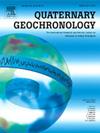挑战性环境中岩石表面的发光测年:MIS5e砾质横切滞积层(南撒丁岛,西地中海)
IF 2.5
2区 地球科学
Q3 GEOGRAPHY, PHYSICAL
引用次数: 0
摘要
由于传统测年方法的固有局限性,确定诸如海洋阶地等精确海平面标志物的年龄往往十分困难。一种适用于岩石表面的基于光学激发发光的新方法在对各种环境中的巨石和卵石表面进行年代测定方面显示出了巨大的前景。我们对五块鹅卵石进行了光学刺激发光岩石表面定年(OSL RSD),这些鹅卵石来自封存最后一个间冰期(海洋同位素阶段 5e)海洋阶地的基底横切滞积层。我们对五块鹅卵石采用了一致的、高度选择性的三步验收标准,结果发现只有一块鹅卵石在埋藏前经过了充分漂白。从 225 摄氏度的后红外刺激信号(pIRIR225)和 50 摄氏度的前红外刺激信号(pIR50/225)得出的年龄分别为 131 ± 8 ka 和 127 ± 8 ka(根据 22 个分析等分样品得出,n = 22)、分别与同一序列的常规发光年龄 ∼135 ka 相一致,也与从珊瑚碎片中获得的 U/Th 年龄 ∼130 ka 相一致。这项工作表明,RSD 是对覆盖在海洋阶地上的砾石表层沉积物进行年代测定的一种很有前途的方法,可以为类似的第四纪沉积物提供新的年代学依据。本文章由计算机程序翻译,如有差异,请以英文原文为准。
Luminescence dating of rock surfaces in challenging environments: The case of MIS5e gravelly transgressive lag deposit (Southern Sardinia, West Mediterranean Sea)
Determining the age of precise sea level markers such as marine terraces is often difficult because of the inherent limitation of traditional dating methods. A novel method based on Optical Stimulated Luminescence applicable to rock surfaces has been showing great promise in dating boulder and cobble surfaces from various environments. We performed Optically Stimulated Luminescence Rock Surface Dating (OSL RSD) on five cobbles from a basal transgressive lag deposit sealing a marine terrace referred to as the Last Interglacial (Marine Isotopic Stage 5e). We applied a consistent and highly selective 3-step acceptance criteria on five cobbles and obtained that only one was sufficiently well-bleached prior to burial. The resulting ages of 131 ± 8 ka and 127 ± 8 ka (obtained on 22 analyzed aliquots, n = 22) derived from the post-infrared infrared stimulated signal at 225oC (pIRIR225) and the preceding infrared stimulated signal at 50oC (pIR50/225), respectively, are consistent with each other as well as with the conventional luminescence age of ∼135 ka from the same sequence and with the U/Th age of ∼130 ka obtained from coral fragments. This work demonstrates that the RSD is a promising method for dating gravel veneer deposits overlaying marine terraces, enabling new chronologies for similar Quaternary deposits.
求助全文
通过发布文献求助,成功后即可免费获取论文全文。
去求助
来源期刊

Quaternary Geochronology
地学-地球化学与地球物理
CiteScore
4.40
自引率
22.20%
发文量
130
审稿时长
20 weeks
期刊介绍:
Quaternary Geochronology is an international journal devoted to the publication of the highest-quality, peer-reviewed articles on all aspects of dating methods applicable to the Quaternary Period - the last 2.6 million years of Earth history. Reliable ages are fundamental to place changes in climates, landscapes, flora and fauna - including the evolution and ecological impact of humans - in their correct temporal sequence, and to understand the tempo and mode of geological and biological processes.
 求助内容:
求助内容: 应助结果提醒方式:
应助结果提醒方式:


